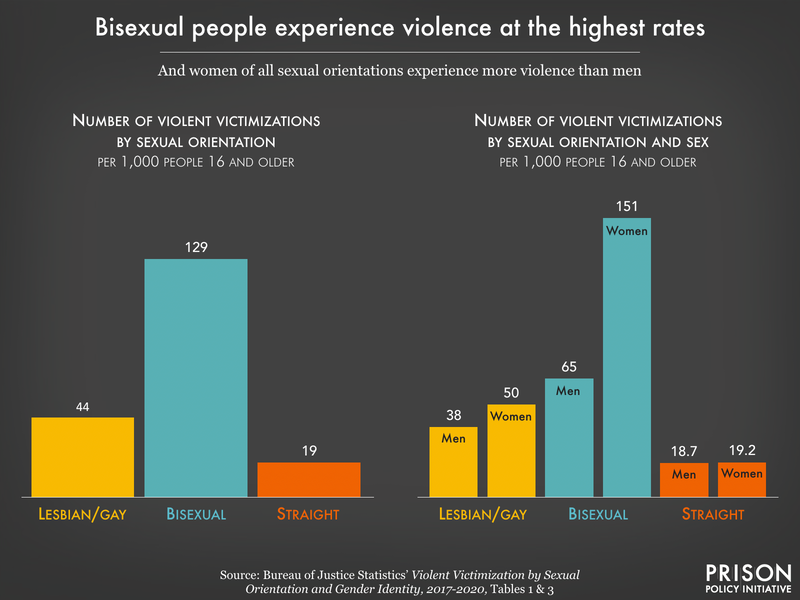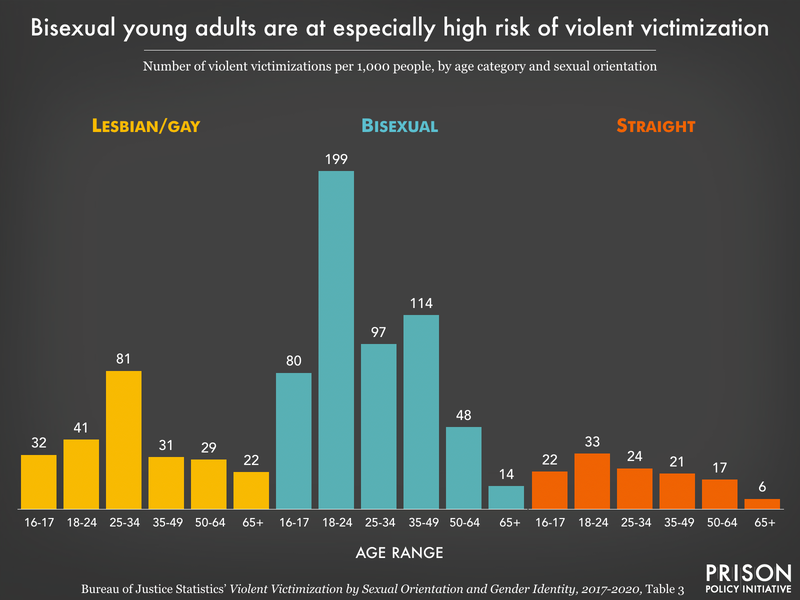New data: LGBT people across all demographics are at heightened risk of violent victimization
A new report from the Bureau of Justice Statistics highlights just how common violent victimization is among women, LGB people, and trans people.
by Emily Widra, July 11, 2022
A new publication from the Bureau of Justice Statistics, Violent Victimization by Sexual Orientation and Gender Identity, 2017-2020, supports the vast evidence we already have that LGBT people — and particularly young adults, people of color, women, and bisexual people — are at heightened risk of violent victimization compared to their straight and cisgender1 counterparts.
We already know that LGBTQ+ people are overrepresented at every stage of the criminal legal system. And the line between victim and perpetrator is often blurry; many people who commit violent crimes have also been victims of violence and trauma throughout their lives. This new data reinforces that the way to break this cycle is not through punishment and incarceration, but rather support for programs that prevent violent victimization in the first place.

Defining violent victimization
The report is based on data from the National Crime Victimization Survey (NCVS), an annual survey collected by the U.S. Census Bureau. The survey asks respondents about experiences of violent crimes, regardless of whether these crimes were reported to law enforcement. For the purposes of this data source, violent crime includes threatened, attempted, or completed occurrences of rape or sexual assault, robbery, aggravated assault, and simple assault.2 The NCVS collects data on people aged 12 and older, but the Violent Victimization by Sexual Orientation and Gender Identity, 2017-2020 report from BJS only reports data for people aged 16 and older.
Violent victimization of transgender people

We already know that transgender people face a significant amount of discrimination and violence: according to the 2015 U.S. Transgender Survey, nearly one in ten respondents were phsyically attacked because of their gender identity, and more than 54% experienced some form of intimate partner violence. This newest report from the Bureau of Justice Statistics supports what we already know about high rates of violence against trans people: the rate of violent victimization of transgender people is 2.5 times higher than the rate among cisgender people.It’s clear that trans people are disproportionately violently victimized: transgender people account for 0.11% of the population 16 and older, but are the victims of 0.27% of all violent victimizations reported from 2017 to 2020 in the NCVS.
Violent victimization of LGB people
Lesbian, gay, and bisexual (LGB) individuals experience violent victimization at rates far higher than their straight counterparts. Lesbian and gay people experienced 44 victimizations per 1,000 people, which was more than twice the victimization rate of straight people (19 per 1,000 people). Bisexual people experienced victimization at almost seven times the rate of straight people and almost three times the rate of lesbian and gay people.
Across all measured demographics – race, sex, and age – bisexual individuals have the highest rates of violent victimization:
Women of all sexual orientations experience higher rates of victimization
Women of all sexual orientations experience higher rates of violent victimization than their male counterparts. The violent victimization rate for lesbian women, for instance, is more than 1.3 times that of gay men (50 per 1,000 vs. 38 per 1,000). The victimization rate is highest among bisexual women, who are victimized at a rate 2.3 times that of bisexual men (151 per 1,000 vs. 65 per 1,000). Straight women experience violent victimization at a rate of 19.2 per 1,000, compared to 18.7 for straight men.
(Unfortunately, the data does not disaggregate trans people by gender, so it is not possible to make a similar comparison.)
More supports and protections are needed
This data reiterates what we already know: Society is failing to protect the safety of LGBT people, especially young adults, people of color, women, and bisexual people. Many trans people, for instance, face systemic disadvantages that work together to put them in danger, including anti-trans stigma (including hostile political policies), denial of opportunity (including exclusion from health care, social services, and education), and increased risk factors (such as engagement in survival sex work).
Survivors of violence advocate for interventions that:
- Expand funding for affirming services for survivors of violence – including LGBTQ people and women – with a focus on accessible medical and mental health services.
- Explicitly include trans, lesbian, gay, bisexual, and queer identities in conversations about intimate partner violence and sexual assault.
- Expand access to affordable housing, a living wage, and non-discrimination policies that transform survivors’ access to basic needs.
- Encourage implementation of community-based solutions to violence designed by community-members who are most affected, such as those incorporating restorative and transformative justice practices.
Above all, survivors of violence emphasize rehabilitation over punishment, prevention over criminalization, and accountability through options beyond prisons and jails.
Footnotes
-
The National Crime Victimization Survey defines cisgender as “an individual whose gender identity is the same as their sex assigned at birth.” ↩
-
The Bureau of Justice Statistics and the National Crime Victimization Survey define aggravated assault as “An attack or attempted attack with a weapon, regardless of whether the victim is injured, or an attack without a weapon when serious injury results,” and simple assault as an “attack without a weapon resulting either in no injury, minor injury (e.g., bruises, black eyes, cuts, scratches, or swelling), or an undetermined injury requiring fewer than two days of hospitalization. Also includes attempted assault without a weapon.” ↩






